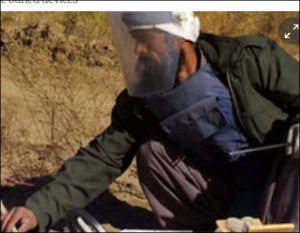
Glowing bacteria offer hope for safe detection of 100m landmines

A team of researchers at an Israeli university has successfully tested a technology using fluorescent bacteria and lasers that could become a safer system for detecting buried landmines. An estimated 100m landmines are scattered in some 70 countries, a legacy of often long-past conflict, and the devices injure up to 20,000 people a year.
Mine clearance work is typically dangerous, labour-intensive and costly. The team at Jerusalem’s Hebrew University has tested mine detection using bacteria genetically modified to give off a fluorescent signal when mines – often made out plastic – are close, which can then be detected with a laser.
Reporting the findings in the journal Nature Biotechnology, the researchers say their approach relies on tiny amounts of vapour given off by the explosives in the mines.
It was recognised that some plants reacted to those vapours, and the research used modified bacteria that essentially glow in contact with the explosive vapour. Encased in polymer beads scattered on the suspected minefield, that fluorescence is then detected by a laser system that researchers suggest could be mounted on a vehicle – including drones.(guardian)…[+]















